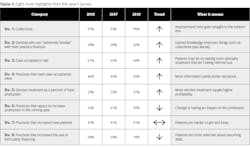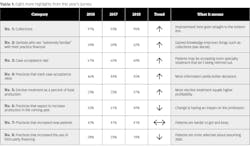A profession in transition: Findings from the 2018 Dental Economics–Levin Group Annual Practice Survey
Like it or not, we live in “interesting times.” You would be hard-pressed to find someone who disagrees with that statement. Pick any topic—the economy, politics, technology, sociology—and you’ve probably seen dramatic shifts in these areas in this past year. This atmosphere of change (some might say upheaval) continues to permanently transform the practice of dentistry in our country. The results of this year’s Dental Economics–Levin Group Annual Practice Survey reflect that reality.
Dentistry, like the United States, has been in a state of transition since the beginning of the Great Recession. Although where we’re headed remains unclear, many changes are taking place.
Dental support organizations (DSOs) and large group practices are growing and here to stay. These types of practices have created a higher level of competition in many areas. DSOs now employ almost one out of every five dentists, and this number will continue to rise. DSOs and large groups provide longer and more convenient hours, accept many or all insurance programs, and typically operate a well-managed model that is highly streamlined and effective. Many are partially or fully owned by private equity firms with the financial wherewithal to invest in growth, which is certain to occur.
Insurance reimbursements continue to decline. Certain regions of the country are experiencing this more significantly than others, but the current trajectory will continue. It is very likely that all services delivered to insured patients will eventually be reimbursed at the PPO level. With the majority of dental practices now participating in one or more insurance plans, a reduction in reimbursements is leading to a reduction in practice production and profitability. We are already seeing this.
Dentists are retiring much later than previously, if at all. The most frequently selected anticipated retirement age for this year’s survey group was 70, with more than two-thirds of dentists—10% more than last year—planning on retiring after age 66. Only 4% expect to retire before age 55. The impact of this trend is immense, as it will reduce the opportunity for younger dentists to advance as rapidly as they might desire in their careers.
Most young dentists are burdened with significant debt from the very beginning of their careers. Student loan debt now slows down the speed at which young dentists seek (or are able) to invest in private practice, which in turn reduces the ability of older dentists to sell their practices at prices that support their retirement needs. This has created a problematic cycle, to say the least.
Seven states now allow midlevel providers. This trend will expand nationally.
New technology carries a large price tag. Investment in new technology initially increases overhead and reduces profit, unless and until the team is fully trained, the technology is fully implemented, and efficiencies are realized.
These and other trends should not be labeled as either positive or negative, but they must be recognized for their capacity to radically change our profession. Some of that change is evident in the answers we received from dentists across the country in this year’s survey. As in previous years, the Levin Group designed the survey and collected the responses. The Levin Group Data Center then analyzed the results and compared them against relevant benchmarks, including the past 12 surveys. Let’s look at what our colleagues had to tell us.
This year’s data, collected from general dentists between March 2018 and June 2018, is reflective of practice performance during the 2017 calendar year. The vast majority of respondents (92.2%) own their practices, and more than three-quarters have been in dentistry for more than 20 years.
Right back to where we were 12 years ago
Before we look at what’s changed in this 12th edition of the Dental Economics–Levin Group Annual Practice Survey, let’s look at some important things that haven’t. In 2018, the average respondent to our survey had 1.9 dentists and 1.7 hygienists working in the practice, combining to produce an average total practice revenue of $1,071,357. Although we have seen modest growth in some of the years since, average total practice production has now reverted back to the same level reported in 2006. Among our survey participants, practice growth has not even kept pace with inflation.
Two other items of note have not changed in 12 years: Of total practice production, 29% came from the hygiene departments with the balance being driven by the doctors, the same ratio as in 2006. It is also noteworthy that dentists in private practice worked four days per week on average in 2018. This average workweek was exactly the same in 2006.
The big changes: Some good, some not so much
Running a practice costs more. Total production has remained flat, but overhead is significantly higher. Over the past decade, average overhead has increased 10% and is now at 66%.
Doctors have added six years to their expected retirement age. In 2006 the average anticipated retirement age reported by doctors was 61.5. In this year’s survey, the average age was 67.5, with two-thirds selecting age 66 or higher as their target for retirement. There is no question that fewer dentists are retiring, and those who do are waiting much longer. This could help explain the next observation . . .
Dentists are grouping up, and not just in DSOs and large group practices. The average number of dentists per private practice has risen from 1.6 to 1.9 in the last 12 years, an increase of almost 20%.
It is not only the hard numbers that are reflecting change in our profession. Doctors’ perspectives have shifted and reveal a realistic concern. When asked to forecast their production results for 2018, fewer than half (49%) of those surveyed expected to see an increase. That is the least optimistic outlook recorded in 12 years of surveys. By comparison, two-thirds (66%) of those who responded to last year’s survey thought production would increase. When we examine other important growth categories, we see similar concern. For example, fewer dentists reported increases in total patients and new patients this year.
It should come as no surprise then to see that more than four out of five (80%) dentists surveyed reported moderate, high, or extremely high levels of stress related to their practices.
Online marketing and social media use continue to grow
Dentists continue to embrace online marketing to attract new patients. Compared to last year, 20% more doctors are using an online marketing service this year. Dentists reported a similar increase in usage of social media platforms: 73% have a Facebook account, 19% tweet, 21% are active on LinkedIn, and 17% are on Instagram (double last year’s number). Only one in five has no social media presence, down from one in four last year.
Keeping the business in-house
Dentists like being the decision makers in their businesses. When asked, “Other than delivering outstanding patient care, what in your practice gives you the most satisfaction?” 50% selected “Being my own boss” as number one. (Not surprisingly, only 4% chose “Managing the business aspects of the practice” as their number-one thing.)
As the practice decision makers, dentists have control over which services they provide and which they refer. The data shows that more production is being kept inside the practice than in previous years. The number of doctors who indicated that the number of patients they refer to specialists had remained the same fell by 10 percentage points, and the number who indicated their referrals to specialists had increased was cut in half.
The trend toward more general dentists providing orthodontic treatment continues. The percentage of doctors reporting that they offer any type of ortho treatment grew again and stands now at 52%, with 90% of that group offering clear aligners.
Conclusion
The changes occurring in dentistry have set us on a new path that may feel unfamiliar. The data collected in this survey, along with other research available in our profession, will serve as valuable guideposts for leading your practice into the future or making career decisions as an associate or employee (table 1). As they say in the investment industry, “Past performance does not necessarily indicate future results.” Still, it can be very useful for making good decisions and identifying your own personal and professional vision and goals.
Your practice is your greatest investment, whether you own it or work there. Take the time. Do your own research. Make a difference in your life and for the patients in your care.

